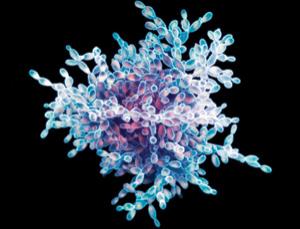中国农大综述胞内溶解型朊蛋白有效模型、试验方法及其变异危
中国农业大学宋志琦及其同事发表文章综述了与朊病关系最为紧密的两种亚型,并介绍了研究胞内溶解型朊蛋白的有效模型和试验方法,介绍了朊病引起的神经退行性疾病。相关文章发表于2013年10月第30期《中国神经再生研究(英文版)》杂志上。

中国农大综述胞内溶解型朊蛋白有效模型、试验方法及其变异危害
海绵状脑病主要是由体内正常细胞表面的朊蛋白转变成致病性朊蛋白所导致,但一直以来,科学家们对朊蛋白与神经退行性疾病关系的研究较少。
值得注意的是,即使在没有致病性朊蛋白存在的情况下,胞内溶解型朊蛋白和跨膜型朊蛋白的错误定位、聚集倾向、信号肽失效,或者在机体应激时等多种情况下,它们一旦不能被及时清除,同样会导致神经退行性疾病的发生。
中国农业大学宋志琦及其同事发表文章综述了与朊病关系最为紧密的两种亚型,并介绍了研究胞内溶解型朊蛋白的有效模型和试验方法,介绍了朊病引起的神经退行性疾病,在脑部的典型病变为:神经细胞海绵状变性、突触结构改变、神经细胞死亡以及蛋白质的聚集等。在人体内稳态的作用下,以上一系列的变化必将导致神经系统启动防御机制,动员小胶质细胞,发挥神经再生功能。
神经系统的退行性病变和神经再生在疾病的发展过程中是彼消此涨的关系。对这些分子作用机制的研究表明,引起阮病的致病因子并非只有致病性朊蛋白,面对复杂的细胞内环境,错误定位或者未及时清除的具有特殊拓扑结构的朊蛋白同样会引起疾病。
原文摘要:
Metabolism of minor isoforms of prion proteins: Cytosolic prion protein and transmembrane prion protein
Zhiqi Song, Deming Zhao, Lifeng Yang
Transmissible spongiform encephalopathy or prion disease is triggered by the conversion from cellular prion protein to pathogenic prion protein. Growing evidence has concentrated on prion protein configuration changes and their correlation with prion disease transmissibility and pathogenicity. In vivo and in vitro studies have shown that several cytosolic forms of prion protein with specific topological structure can destroy intracellular stability and contribute to prion protein pathogenicity. In this study, the latest molecular chaperone system associated with endoplasmic reticulum-associated protein degradation, the endoplasmic reticulum resident protein quality-control system and the ubiquitination proteasome system, is outlined. The molecular chaperone system directly correlates with the prion protein degradation pathway. Understanding the molecular mechanisms will help provide a fascinating avenue for further investigations on prion disease treatment and prion protein-induced neurodegenerative diseases.

